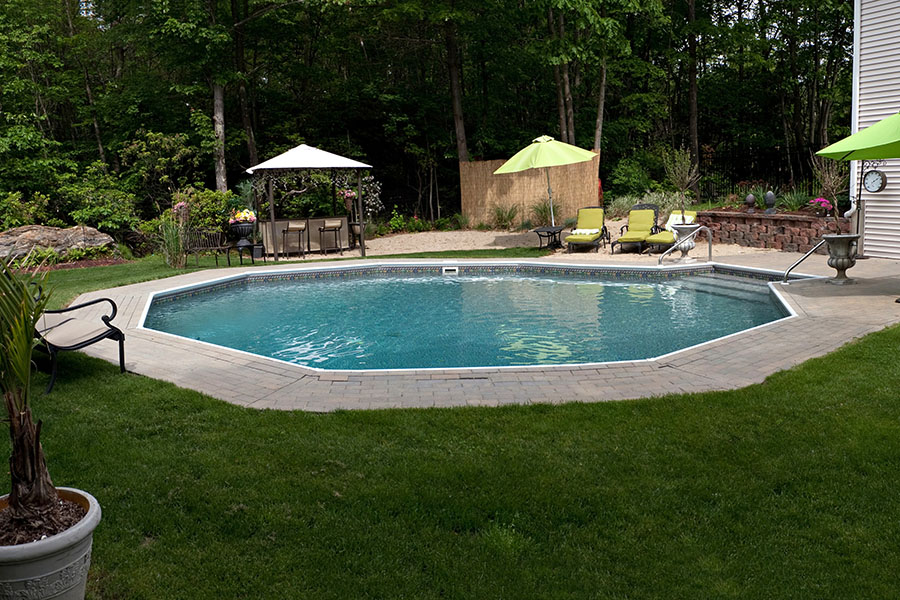Constructing an inground pool in Arizona’s arid and sun-drenched environment presents a unique set of challenges that require careful planning and execution. From navigating local regulations to dealing with the intense heat and varied soil conditions, every step in the pool building process needs to be meticulously managed. This comprehensive guide provides an in-depth look at each essential phase of the process and how Scholz Rebar can provide crucial support with our expert rebar solutions.
Initial Considerations to Planning Your Pool
The journey to a beautiful and functional inground pool begins with thorough planning. Arizona’s climate necessitates a design that not only complements the landscape but also stands up to the harsh desert conditions.
Define the Purpose and Design: Start by clearly defining the primary use of your pool. Whether it’s for relaxation, fitness, or entertainment, this will dictate the size, shape, and features of the pool. A pool designed for exercise might incorporate a lap lane and deeper sections, while a pool meant for entertaining may include a shallow area for lounging and a swim-up bar.
Assess Your Property: Conduct a detailed assessment of your backyard’s size, shape, and slope. Arizona properties often feature diverse terrains that can influence pool placement. Consider factors such as soil type, drainage, and the potential impact of landscaping. If your property has a slope, you may need to address grading and terracing to accommodate the pool’s design.
Climate Considerations: Arizona’s intense sunlight and heat mean that your pool design should include features that enhance comfort and efficiency. Consider installing shaded areas or incorporating water features that can provide cooling effects. Additionally, design your pool to maximize energy efficiency by including features like solar heating and energy-efficient pumps.
Navigating Local Requirements for Permits and Regulations
Understanding and complying with local regulations is crucial for a smooth pool construction process. Arizona has specific codes and requirements that must be followed to ensure safety and compliance.
Local Building Codes: Each city or county in Arizona has its own set of building codes that govern pool construction. These codes address various aspects, including pool dimensions, safety barriers, and structural integrity. Familiarize yourself with these codes to ensure your pool meets all necessary standards.
Permit Acquisition: Securing the proper permits is a necessary step before construction begins. The process typically involves submitting detailed plans, paying application fees, and scheduling inspections. It’s essential to follow the correct procedures to avoid delays or legal issues.
HOA Guidelines: If your property is part of a homeowners’ association (HOA), check their guidelines for pool construction. HOAs often have additional rules or aesthetic requirements that must be adhered to. Securing HOA approval early in the process can help avoid potential conflicts later on.
Designing Your Pool for the Desert Environment
Designing a pool that can withstand Arizona’s desert climate involves selecting materials and features that offer durability and efficiency.
Material Choices: Choosing the right materials is vital for a long-lasting pool. Concrete and fiberglass are popular choices due to their strength and minimal maintenance requirements. Concrete pools can be customized with various finishes, while fiberglass pools offer a smoother surface and faster installation.
Energy Efficiency: Incorporate energy-efficient features into your pool design to reduce operating costs and enhance performance. Variable-speed pumps are a great choice as they adjust to the pool’s needs, conserving energy. Solar heaters can also be beneficial, leveraging the abundant Arizona sunshine to warm the pool water.
Landscaping Integration: Integrating landscaping around the pool area can enhance both its functionality and appearance. Opt for desert-friendly plants that require minimal water and are resilient to the harsh sun. Consider hardscaping options such as stone pathways and decorative walls to complement the pool’s design.
Excavation and Foundation Work for Site Preparation
Proper site preparation is essential for creating a stable foundation for your pool. This phase involves careful excavation and construction to ensure the pool’s longevity.
Excavation: Excavate the pool site according to the exact dimensions and shape of your design. This step requires precision to ensure the pool will meet the planned specifications. Proper excavation also involves clearing the site of debris and obstacles, making it accessible for construction equipment.
Foundation Reinforcement: The foundation work includes installing a rebar framework to reinforce the pool’s structure. This rebar framework is crucial for supporting the concrete shell and preventing cracks. Scholz Rebar specializes in providing high-quality rebar solutions to ensure a solid and durable foundation for your pool.
Drainage Considerations: Effective drainage is critical to prevent water damage and ensure the pool’s stability. Incorporate drainage systems to direct water away from the pool area and avoid issues related to erosion or soil saturation.
Shell Installation for Building the Pool Structure
The construction of the pool shell is a key phase that determines the pool’s overall strength and durability.
Rebar Framework: Begin by installing a detailed rebar framework within the excavated site. This reinforcement is essential for providing structural support and preventing potential cracks. Scholz Rebar offers expertise in crafting and placing rebar to ensure the pool shell is robust and resilient.
Concrete Pouring: Pour concrete over the rebar framework to form the pool’s shell. This process requires careful attention to detail to achieve a smooth and even surface. The concrete must be allowed to cure properly to gain strength and durability.
Finishing Touches: Once the concrete has cured, apply a finishing layer to the pool’s interior. Options include plaster, pebble aggregate, or other specialty finishes. These finishes enhance the pool’s appearance and provide a smooth surface for swimmers.
Plumbing and Electrical Work
Proper installation of plumbing and electrical systems is crucial for the pool’s operation and safety.
Plumbing System: Install the plumbing system, including pipes for water circulation, filtration, and heating. Ensure the system is designed to handle Arizona’s water conditions and temperatures. Properly installed plumbing is essential for maintaining clear and clean pool water.
Electrical Components: Set up electrical components such as lighting, pumps, and heaters. All electrical work must be performed by a licensed electrician to ensure compliance with local codes and safety standards. Proper installation of electrical systems is vital for the pool’s functionality and user safety.
Filling and Balancing the Water
After the pool’s structure and systems are in place, the final steps involve filling the pool with water and balancing its chemistry.
Water Filling: Begin the process of filling the pool with water, which can take several hours or even days depending on the pool’s size and water source. Monitor the filling process to ensure it is completed correctly.
Chemical Balancing: Once the pool is filled, test and adjust the water chemistry. Properly balanced water is crucial for maintaining clarity and ensuring a safe swimming environment. Adjust the pH levels, chlorine concentration, and alkalinity as needed.
Landscaping and Final Touches
The final phase of pool construction involves landscaping and adding finishing touches to create a beautiful and functional outdoor space.
Landscape Design: Enhance the pool area with desert-friendly landscaping. Choose drought-resistant plants and consider incorporating hardscaping elements such as stone paths and decorative features. Well-designed landscaping can complement the pool and create an inviting outdoor environment.
Additional Features: Consider adding extra features to your pool area, such as waterfalls, fire pits, or outdoor kitchens. These additions can enhance the pool’s functionality and create a more enjoyable and versatile outdoor living space.
Scholz Rebar: Arizona’s Premier Rebar Specialist
At Scholz Rebar, we are dedicated to providing top-quality rebar solutions that ensure the structural integrity of your pool. As Arizona’s leading rebar specialists, we offer a comprehensive range of services tailored to meet the unique needs of every pool project.
Our services include:
- New Pool & Spa Construction: Expert consultation and precise rebar placement to create a strong foundation and achieve a visually appealing result.
- Pool & Spa Remodels: Specialized rebar solutions to revitalize and reinforce existing pools, ensuring seamless integration and enhanced support.
- Custom Water Features: Custom rebar designs for water features and fountains that enhance your landscape and stand the test of time.
- Modern Design Solutions: Innovative rebar configurations for contemporary designs that combine aesthetics and functionality.
Our goal is to exceed your expectations and deliver a solid foundation for your aquatic dreams. Contact us today to learn how we can support your pool project and ensure a successful outcome. Visit our website to explore our full range of services and discover how Scholz Rebar can help bring your vision to life.
Building an inground pool in Arizona’s desert climate involves navigating a variety of challenges. By following this detailed guide and partnering with experts like Scholz Rebar, you can ensure a successful and enduring pool construction project that enhances your home and withstands the demands of the desert environment.

